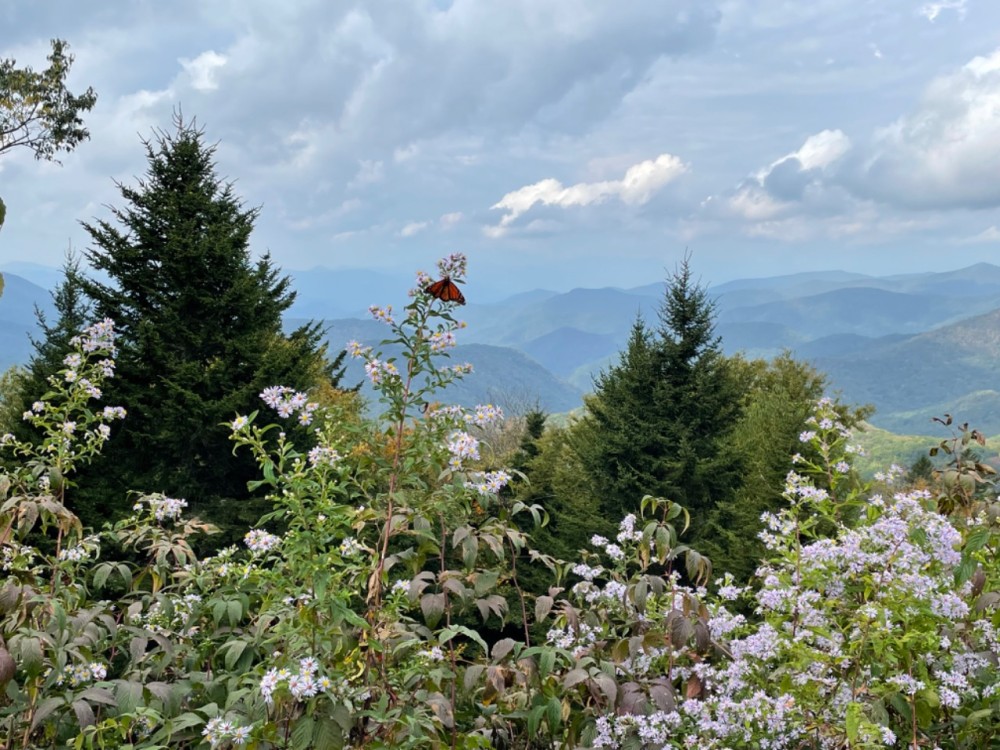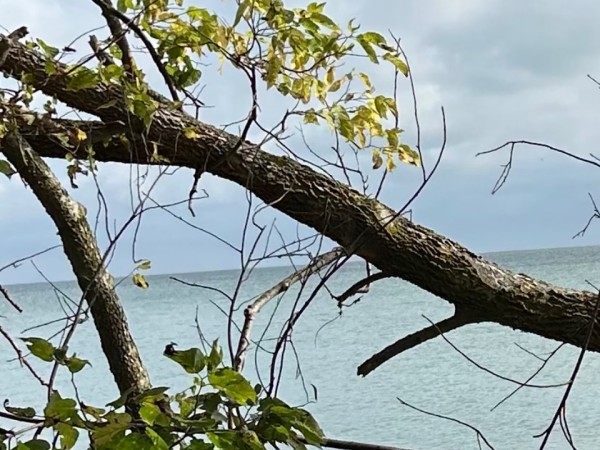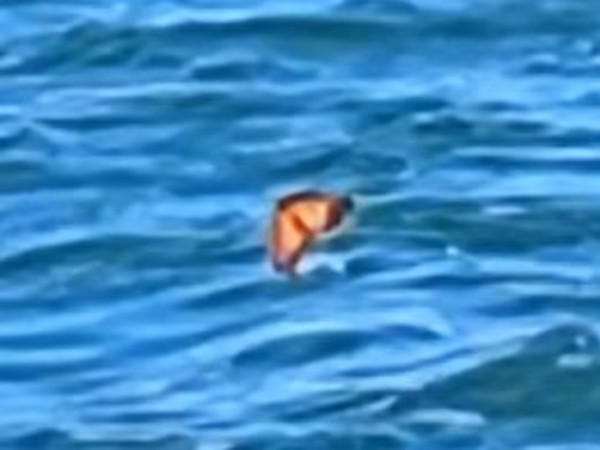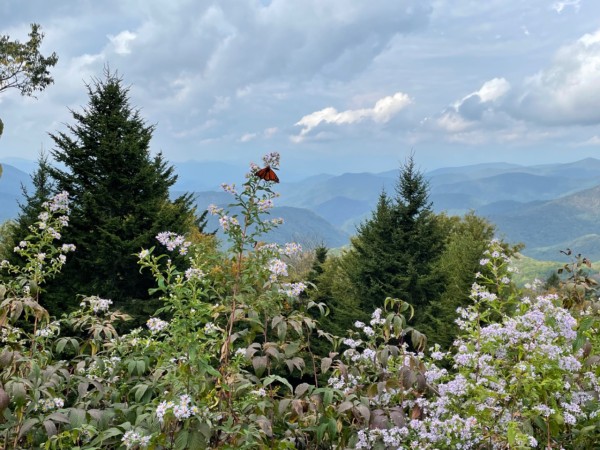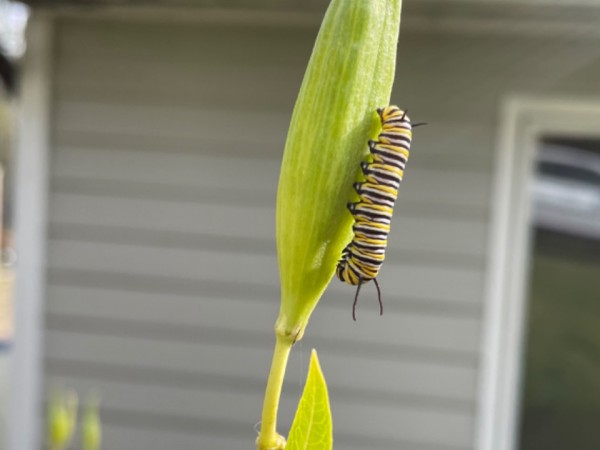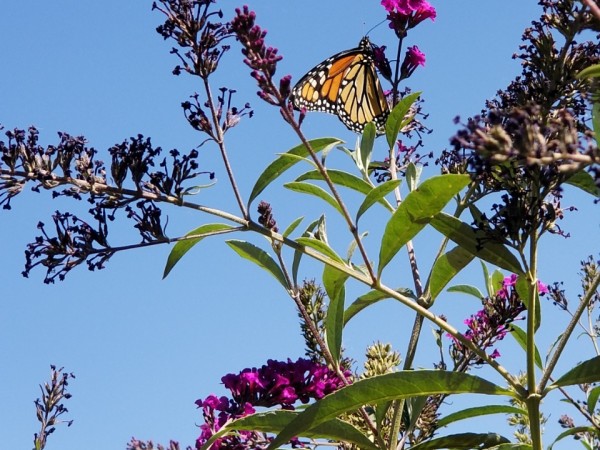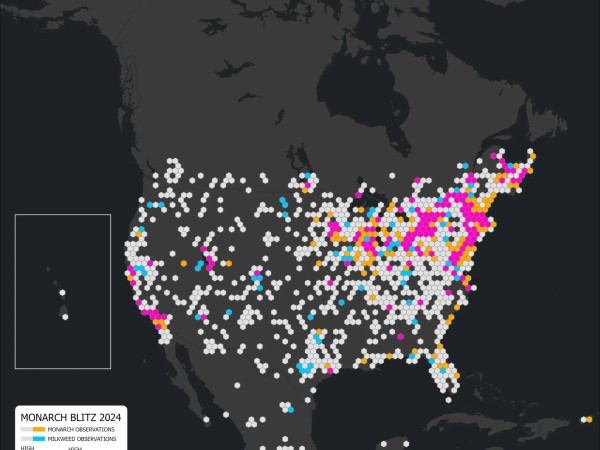Monarchs crossing Lake Erie, still roosting in Great Plains states
As September gives way to October, sightings continue to roll in from dedicated Journey North volunteers, painting a picture of the fall migration story.
Around the eastern half of Lake Erie, where monarchs congregate before making the jump of 30 miles or more across this Great Lake, we can see the migration path as it forms.
Crossing Lake Erie
Point Pelee National Park, which juts south into Lake Erie from Ontario, is a common place to view monarchs on the fall migration before they cross the lake. Laura reported 34 monarchs from the park on Sept. 25, many in “loose groupings of between three and six.”
Over the middle of the lake, Bryan reported a monarch from the water on Sept. 21, writing, “I never expected to encounter a butterfly in the middle of Lake Erie. It was flying low to the water heading south. Weather conditions were clear sunny skies, 80'F, winds out of the West at 10kts.”
On Sept. 24, Karen in Eastlake, Ohio reported 204 monarchs from a balcony on Lake Erie, reporting, “From 1:00 p.m. to 3:00 p.m. floating by my balcony on Lake Erie. 1 or 2 at a time. So peaceful, beautiful. I wrote a poem!”
The following day, Tom in Cleveland, Ohio reported 500 from Wendy Park: “Wind and rain started on 9/24/24 and reports started in the late afternoon that Monarchs were arriving at Wendy Park where historically have seen large roosts. We have not had this kind of weather for many weeks, the kind of weather that encourages Monarchs to take shelter. I went to Wendy Park the next morning, 9/25/24.”
More will likely continue to make the journey across Erie in the weeks to come.
Last year's final report from Point Pelee came on Nov. 11. In that report, longtime Journey North volunteer Darlene Burgess, who submitted more than 700 Journey North reports over the years, many of them from Point Pelee, said the latest she had seen a monarch at Point Pelee was Nov. 20 and the latest on record was Dec. 4.
From the Upper Midwest
The northernmost sightings from the eastern monarch population came from Duluth, Minnesota (latitude 46.8) and Thunder Bay, Ontario (latitude 48.4).
In Duluth, Linda wrote on Sept. 25, “Migrant female on tithonia and cosmos. 3-4 migrants these past couple days.”
Philippe in Thunder Bay reported a singular adult flying south on Sept. 24.
Last year, the final report from northern Minnesota came on Oct. 3 with a report from Barnesville, Minnesota on the western end of the state, so these may well be among the last Journey North reports received from this region. If you’re seeing them near you in the next few weeks, please continue to send in your reports with a photo, which helps verify the sightings!
Roosting in the heartland states
Moving south through the heartland, monarchs are being reported in large groups along the central flyway. Jacque reported over 200 monarchs on eight acres of restored prairie in Manhattan, Kansas on Sept. 24 and Melissa reported “thousands” in Waverly, Nebraska on Sept. 21.
Bruce in Hartley, Iowa, said it was a late roost for the area when reporting a Sept. 20 observation, writing, “Before sunset last night we had over 65 monarchs in the yard trees...this morning 39 could still be accounted for...they're up and flying around now. This is the latest monarch roost we have ever recorded here...”
Last year, Bruce reported roosts from Hartley on Aug. 26, 27 and 29, as well as Sept. 7 and 8.
Along the East Coast
We haven’t received any roost reports from the eastern flyway yet, so if you’re seeing monarch roosting activity, don’t forget to submit your observations!
Theresa in Canton, North Carolina submitted a beautiful photo from the mountains on Sept. 24 with a report of 30 monarchs, writing, “We saw at least 30 Monarchs feeding on the long row of asters at Caney Fork Overlook on the Blue Ridge Parkway around noon. It was cloudy and 64 degrees with little wind.”
Jacqueline in Folly Beach, South Carolina reported 180 along the coastline on Sept. 17, and further south in Jacksonville, Florida, Cory reported 21 on Sept. 22.
At least some monarchs remain on the northeast coast as well, Anne Marie in Canning, Nova Scotia reporting sightings on Sept. 23 and 24. Victoria in Chester, Nova Scotia, reported one emerging from its chrysalis on Sept. 24 along with seven larvae and Aline in Meteghan, Nova Scotia reported 12 larvae “in their last stages.”
From the West: an update from Gail Morris
Monarch sightings across the West are increasing as the migratory generation ecloses, fuels on nectar for their journey and takes to the skies. Everyone is looking to California hoping for a healthy overwintering population this year. Reports from the western states breeding areas are mixed and your reports paint an early snapshot of what this year’s population may look like.
Recent Monarch Sightings
Shelly in Liberty Lake, Washington found a monarch visiting her yard on Sept. 24, writing, “It was happily going all around the Aster flowers today.” In Caldwell, Idaho, Lisa didn’t find any eggs or larvae this year but she did find a monarch visiting her zinnias on Sept. 22.
Martina in Ogden, Utah reported on Sept. 14, “After seeing no monarchs since late August, I was excited to spot this one. 25 C, no wind, clear skies and full sun. This was sadly a meager summer for finding monarch eggs or caterpillars, despite growing more milkweed than ever before, on our property. Milkweed is now dying off and seeds are flying. I noticed over the years that the monarchs spent a lot of time nectaring on this butterfly bush despite lots of other bloom options in the yard.”
Pam in Colorado City, Arizona, just south of the Utah border, spotted two monarchs on Sept. 14. “One was tattered and near the end of its life, but the other was freshly eclosed and appeared to be a migrator judging by its size. Meanwhile, Kate in Beatty, Nevada saw just one monarch on the same day: "lone adult monarch flying through spring area.”
The Journey North maps reveal monarchs flying southward along the California coast. Will they be the early arrivals at the overwintering sites soon?
From the Field
We wait and watch as early reports of monarchs begin to fill the sighting maps. Harsh extreme temperatures blanketed the southern region of California, Nevada and Arizona with record heat and everyone is hoping fall nectar stands are still available for migrating monarchs on their journey.
In general, reports of monarchs are mixed and the coming weeks will offer more answers regarding what the overwintering population will look like. Kristy Baum in Los Angeles reports, “We have had a halt of all monarch activity going on two weeks now over a wide area of Los Angeles.” So, we wait and watch to see if this changes soon or if it will be a pattern over the upcoming weeks." Your reports will help us see the monarch activity in real-time.
As the leading edge of the migration rolls through Arizona, we continue to find lower numbers of monarchs than usual in all the traditional areas of the state during tagging expeditions. Record-shattering heat continues to envelop the lower deserts, keeping monarchs away and waiting for cooler weather before sailing in. So, we hope and wait for them as the season progresses.
Wanted: Your Monarch Sightings
We need your monarch sightings! Report adult monarch, eggs or larvae to Journey North. Your detailed description of what you see can include, but is not limited to, the monarch’s gender and activity. If known, include the type of flowers if they are nectaring or milkweed type if laying eggs. Photos are encouraged and welcomed with all your reports.
Gail Morris is the coordinator of the Southwest Monarch Study (www.swmonarchs.org). She is also a Monarch Watch conservation specialist, the vice president of the Central Arizona Butterfly Association and sits in several western working groups. The Western Monarch News is based on comments provided to Gail Morris. We hope to increase the number of sightings and therefore photos and comments entered into Journey North. We rely on the volunteers who communicate regularly with Gail and who agree to participate in our effort to increase awareness of the population of western monarchs. You can reach her at gail@swmonarchs.org
Monarch Blitz results
This year’s Monarch Blitz saw record-breaking volunteer participation levels. From July 26 to Aug. 4, more than 5,000 people across Canada, Mexico and the United States submitted in excess of 11,000 observations, totaling more than 16,000 monarchs and 68,000 milkweed plants.
Of these, over 2,500 reports came directly to Journey North, totaling more than 7,000 monarch adults, larvae and eggs and numerous milkweed plants. Whether you submitted your observations to Journey North or one of our Monarch Blitz partners, we want to say thank you to everyone who dedicated their time and answered the call to support the North American effort to protect and conserve monarch butterflies throughout their migratory range.
Learn more about the importance and impact of these observations.

